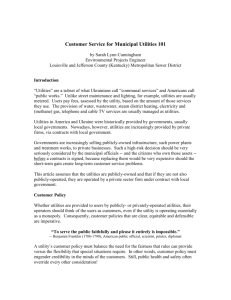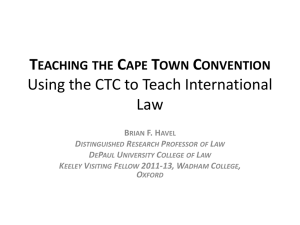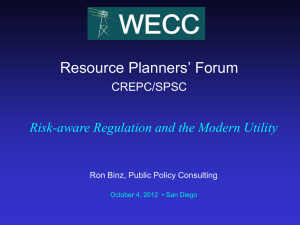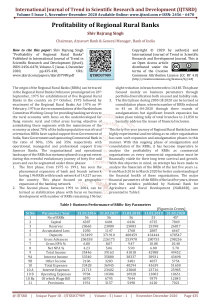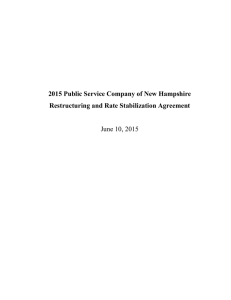Rate Reduction Bonds - Vanderbilt Avenue Asset Management
advertisement
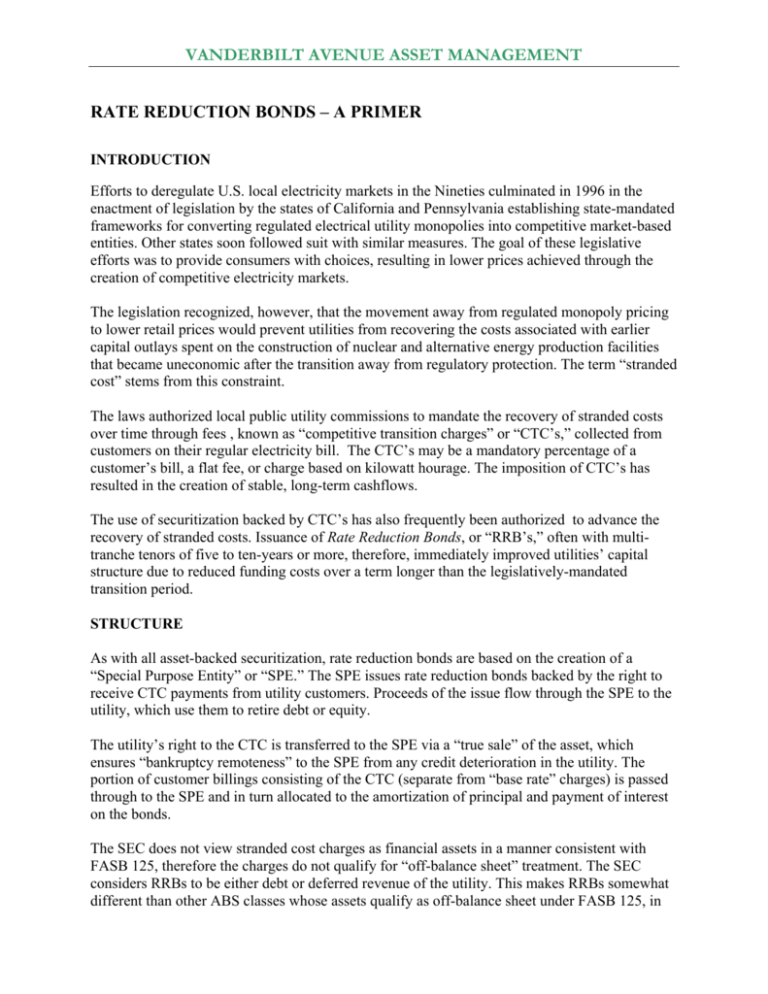
VANDERBILT AVENUE ASSET MANAGEMENT RATE REDUCTION BONDS – A PRIMER INTRODUCTION Efforts to deregulate U.S. local electricity markets in the Nineties culminated in 1996 in the enactment of legislation by the states of California and Pennsylvania establishing state-mandated frameworks for converting regulated electrical utility monopolies into competitive market-based entities. Other states soon followed suit with similar measures. The goal of these legislative efforts was to provide consumers with choices, resulting in lower prices achieved through the creation of competitive electricity markets. The legislation recognized, however, that the movement away from regulated monopoly pricing to lower retail prices would prevent utilities from recovering the costs associated with earlier capital outlays spent on the construction of nuclear and alternative energy production facilities that became uneconomic after the transition away from regulatory protection. The term “stranded cost” stems from this constraint. The laws authorized local public utility commissions to mandate the recovery of stranded costs over time through fees , known as “competitive transition charges” or “CTC’s,” collected from customers on their regular electricity bill. The CTC’s may be a mandatory percentage of a customer’s bill, a flat fee, or charge based on kilowatt hourage. The imposition of CTC’s has resulted in the creation of stable, long-term cashflows. The use of securitization backed by CTC’s has also frequently been authorized to advance the recovery of stranded costs. Issuance of Rate Reduction Bonds, or “RRB’s,” often with multitranche tenors of five to ten-years or more, therefore, immediately improved utilities’ capital structure due to reduced funding costs over a term longer than the legislatively-mandated transition period. STRUCTURE As with all asset-backed securitization, rate reduction bonds are based on the creation of a “Special Purpose Entity” or “SPE.” The SPE issues rate reduction bonds backed by the right to receive CTC payments from utility customers. Proceeds of the issue flow through the SPE to the utility, which use them to retire debt or equity. The utility’s right to the CTC is transferred to the SPE via a “true sale” of the asset, which ensures “bankruptcy remoteness” to the SPE from any credit deterioration in the utility. The portion of customer billings consisting of the CTC (separate from “base rate” charges) is passed through to the SPE and in turn allocated to the amortization of principal and payment of interest on the bonds. The SEC does not view stranded cost charges as financial assets in a manner consistent with FASB 125, therefore the charges do not qualify for “off-balance sheet” treatment. The SEC considers RRBs to be either debt or deferred revenue of the utility. This makes RRBs somewhat different than other ABS classes whose assets qualify as off-balance sheet under FASB 125, in VANDERBILT AVENUE ASSET MANAGEMENT that the “Business Trust” format is used to create the bankruptcy remote entity, as opposed to a grantor or owner trust format. A business trust is “looked through” for accounting and tax purposes, allowing for the critical true sale legal opinion upon which bankruptcy remoteness depends. Also, legislation often specifically recognizes the transfer of stranded cost charges as a true sale, which despite being “on balance sheet,” effectively mandates bankruptcy remoteness. Individual legislation has, however, differed from state to state and is carefully examined. A key feature of much stranded cost securitization is known as a “True Up Mechanism.” Projected cashflows on RRBs are based on utilities’ comprehensive historical data on market demand based on seasonal weather patterns, economic activity, customer composition, and demographics. If, in a given period, some downward shift in the demand curve occurs resulting in revenue insufficient to cover payment of principal and interest to RRB investors, the CTC will be increased in order to create sufficient cashflow to cover the obligation. This process functions in the opposite manner as well. As a result of the state mandates backing stranded cost securitizations, the effect is to provide credit enhancement guaranteeing the projected flow of funds to investors, making RRBs relatively less risky than competing ABS classes relying on other structural forms of credit enhancement. Triple-A credit ratings result. Rate reduction bonds may also be enhanced by 50 basis point reserve funds as well. Servicing of RRBs is also enhanced via the true up mechanism. Utilities service the receivables generated by their individual customer base, therefore, credit status of the utility becomes an element in the assessment of RRB value. ELECTRICITY MARKETS Electricity markets are unique from state to state depending upon the previously mentioned deregulatory initiatives passed therein, as well as the geographic, climate, population, and economic development patterns exhibited (e.g. industrial vs. agricultural concentrations.) The well-publicized problems encountered in the California markets during Summer 2001 were, in part, a result of the specific approach mandated by that state’s deregulatory legislation, which prevented utilities from passing the increased wholesale costs of acquired power through to customers. These constraints imposed severe operating difficulties upon the affected utilities, ultimately forcing Pacific Gas and Electric to declare bankruptcy. Also, grass roots challenges to legislation have contributed to the “headline risk” sometimes associated with RRBs. To date, significant legal challenges to legislation authorizing issuance of RRBs have been unsuccessful in various jurisdictions. TIERING The unique, often esoteric, differences between states’ electricity markets based on the above points (and by no means limited to those) has led to a tiering framework in RRBs. Benchmark states include New Jersey and Connecticut. Characteristics of these states’ markets include well-rated utilities with the right to recover costs, an attractive mix between residential/industrial customers, and a lack of legal challenges to enacted legislation. VANDERBILT AVENUE ASSET MANAGEMENT Behind these lie a large mid-tier of states where risk is perceived to be relatively greater due to a unique issue, such as utility credit weakness, nature of the deregulatory initiative passed, prospective legal or legislative questions (such as a pending voter propositions), or extreme industrial customer base concentration. Such is often the case with Eastern and Mid-Western states. The weakest tier consists of the securities of California utilities, which, despite solid legal foundations, and defeat of grass roots rollback initiatives, were issued during a period of strong economic growth, alleged power supply manipulation, and enflamed passions, resulting in severe distress for the utilities. Restabilization of the California energy market is expected to bolster performance of this tier in the long-run, given its inherent quality. RELATIVE VALUE Relative to other ABS sectors, RRBs provide returns similar to consumer-based receivables sectors like credit cards and auto loans, but have recently been subject to headline risk that has caused performance to lag competing sectors, despite AAA ratings. As these issues have resolved themselves, the differential has subsided. The AAA credit quality of RRBs has also become attractive to traditional corporate bond investors due to the dearth of AAA issuance available in that sector. An advantage of RRBs is their superior cashflow stability, based on legislatively mandated competitive transition charges and associated true-up mechanisms, and low prepayment risk. Also, RRBs experience reduced delinquency and default performance patterns relative to other consumer receivables due to the inelasticity of demand for electrical power in regions with strong residential concentrations. Whereas charge-offs in the credit card and auto loan ABS can increase substantially in periods of economic weakness, with rising unemployment and personal bankruptcies, residential demand for electrical power rarely wanes, creating a relatively more stable pool of receivables featuring a superior AAA credit profile.
